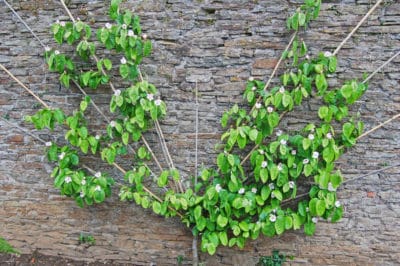Benefits of a Quince Espalier
Delightful spring flowers, aromatic fruit and long, flexible branches make quince trees perfect espalier candidates. In return for beautifying their space, they’ll benefit from:
- Pruning that channels energy away from vertical growth and into the fruit-bearing spurs.
- Fewer broken branches.
- An increase in their fruit-bearing life.
- Improved air circulation and decreased pest and disease problems.
- Faster-ripening fruit.
- Easier pest treatment and harvesting.
How to Espalier Quince
The quickest way to espalier a quince is to start with a two-year old, partially trained tree grown on a fan support. Even this method, however, requires two years to create a recognizable fan.
Things you’ll need:
- Heavy-gauge galvanized wire
- Wire cutters
- Planting spade
- Sharp pruners
- Soft, stretchy material or plant ties
- Scissors
- Bamboo canes (optional)
- String lengths of heavy-gauge, galvanized wire horizontally along your wall beginning 15 inches from the ground. Position them between 1 ½ and 4 inches in front of it and 6 inches from each other.
- Plant the tree in early spring. Position it between 6 and 9 inches in front of — and sloping just slightly towards — its permanent support.
- Prune its vertical, central leader back to two or more low, vigorous side branches growing at a 45-degree angle from the leader.
- Prune the side branches back by one-third (two-thirds if they haven’t done any branching of their own).
- In summer, select four shoots on each of the side branches — one at the tip, two on the upper side and one on the underside. Try to find similarly spaced shoots.
- Tie the shoots to your wire grid with soft, stretchy material. Arrange them in a fan formation at a 30-degree angle to the branches. If they need extra support, tie bamboo canes to the wires first.
- Remove untied shoots that grow toward the wall. Then pinch the ones remaining back to a single leaf.
- The next spring, prune each of the original side branches back by a third. Make each cut at an upward-facing bud.
- When the tips of original side branches have grown out sufficiently, tie them into the grid along with any side shoots you need to conceal empty spaces.
Expert gardener’s tip: To reduce leafy growth and maintain the fan shape, prune your quince espalier in summer. Pruning in dry weather reduces the chance of fungal infection.
